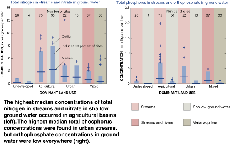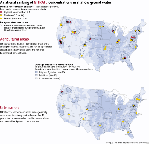
The highest nitrogen and phosphorus concentrations generally were found in agricultural and urban streams. Nutrient concentrations in areas of mixed land use were lower than in agricultural or urban areas but were higher than in undeveloped areas. Orthophosphate concentrations in ground water typically were so low that relations to land use are not definitive.
 |
| image size 35KB--gif |
Except for nitrogen in agricultural areas, nutrient concentrations in streams generally were higher than those in shallow ground water, regardless of land use. In agricultural areas, nitrate concentrations in shallow ground water typically were higher than total nitrogen concentrations in streams, although exceptions occurred in areas where soil characteristics restrict downward movement of water.
Regional patterns in nutrient concentrations can be useful for determining areas of the Nation where environmental settings deserve the greatest concern and attention. The discussion and maps on pages 41-45 focus on geographic patterns in relation to land use and nutrient inputs. Methods used to construct the maps are explained on page 31.
 |
| image size 81KB--gif |
High concentrations of nitrate in shallow ground water were widespread and strongly related to agricultural land use, but there were no apparent regional patterns. Based on comparisons with background concentrations, human activities have increased nitrate concentrations in ground water for about two-thirds of agricultural areas studied, compared to about one-third of urban areas. Median nitrate concentrations for 13 of 36 agricultural areas were greater than 5 mg/L and ranked among the highest of all shallow ground-water studies. Only 1 of 13 urban areas fell into this high-concentration group. It is likely that nitrogen sources in urban areas are relatively localized when compared with the generally more intensive and widespread use of fertilizers on cropland. Also, the impervious surfaces typically found in urban areas generally result in surface runoff of nutrient-laden water, rather than seepage to ground water.
NITROGEN IN STREAMS
Average annual concentrations of total nitrogen in about 50 percent of agricultural streams ranked among the highest of all streams sampled in the first 20 Study Units, and concentrations in about 36 percent of urban streams were among the highest measured. In contrast, total nitrogen levels in streams draining relatively undeveloped, forested watersheds (not shown on the national maps) ranked among the lowest of all streams sampled.
High concentrations of nitrogen in agricultural streams correlated with nitrogen inputs from fertilizers and manure used for crops and from livestock wastes. The Upper Midwest is a notable region of high nitrogen levels in agricultural streams; however, there are also many such examples in the West and East. High nitrogen levels in urban streams probably were related to nitrogen introduced from fertilizers applied to suburban lawns and golf courses, emissions from automobiles and electric powerplants, and effluent from sewage treatment facilities.
Streams and large rivers that drain areas of mixed land use had average annual concentrations of total nitrogen at various levels across the Nation, with no apparent regional pattern. The highest average annual concentrations occurred in watersheds with the highest nitrogen inputs and in rivers downstream from major metropolitan areas. The lowest concentrations in streams draining areas of mixed land use were for watersheds having considerable proportions of forest.
For all streams sampled, the highest concentrations of total nitrogen corresponded to broad patterns of nitrogen inputs from agricultural and urban areas. Coastal waters near such areas of high nitrogen input are at greatest risk of eutrophication.
In most streams draining agricultural, urban, or mixed land use, concentrations of total phosphorus were greater than background concentrations and the USEPA desired goal for preventing nuisance plant growth in streams. About one-half of urban streams had average annual concentrations of total phosphorus that ranked among the highest measured in the first 20 Study Units. The highest average annual concentrations of total phosphorus were in streams near metropolitan areas in the semiarid western and southwestern regions of the Nation. Examples include the Santa Fe River downstream from Santa Fe, New Mexico; Las Vegas Wash downstream from Las Vegas, Nevada; and the South Platte River downstream from Denver, Colorado. In these areas, discharges from wastewater treatment plants can be a significant proportion of the streamflow.
The broad geographical pattern observed for concentrations of total nitrogen in streams also holds true for concentrations of total phosphorus. This comparability is not surprising because proportions of nitrogen and phosphorus fertilizer used across the Nation are similar. Elevated phosphorus concentrations in agricultural streams can also come from livestock waste, such as in Prairie Creek in the Central Nebraska Basins, or from poultry wastes, such as in streams of the Apalachicola-Chattahoochee-Flint River Basin and the Ozark Plateaus. In addition, agricultural sites can be affected by effluent from upstream wastewater treatment plants, such as in Turlock Irrigation District Lateral 5 in the San Joaquin-Tulare Basins. Some high concentrations of phosphorus can occur naturally. For example, concentrations of phosphorus in the Pembina River of the Red River of the North Basin were high because most agricultural land in this area includes phosphorus-rich soils in relatively steep, easily eroded terrain; high concentrations of phosphorus in some streams in the Albemarle-Pamlico Drainage were derived from ground water in contact with phosphate minerals.
| Phosphorus transport in watersheds is complex. Phosphorus commonly attaches to soil particles and either remains close to application areas or moves to streams primarily by soil erosion. As phosphorus levels increase in some soils, a larger amount is available for transport in the dissolved form. This amount varies according to the phosphorus adsorption capacity of the soil. Areas with high levels of soil phosphorus relative to their soil adsorption capacity export relatively large amounts of phosphorus to streams. |
Concentrations of total nitrogen and total phosphorus typically were low in large rivers that drain areas of mixed land use. Examples include the Altamaha River, Georgia; Connecticut River, Connecticut; Menominee River, Wisconsin; and Upper Snake River, Idaho. In these large watersheds, streams draining forested and other relatively undeveloped land dilute nutrient-rich runoff from agricultural and urban areas. A few large rivers (such as the South Fork of the Palouse River, Washington, and the Trinity River, Texas) had extremely high average annual concentrations of total nitrogen and (or) total phosphorus that can be attributed primarily to the effect of upstream discharges of wastewater effluent. Large watersheds dominated by agricultural land, such as in the Great Plains and Upper Midwest, also exhibited concentrations of total phosphorus that ranked among the highest measured.